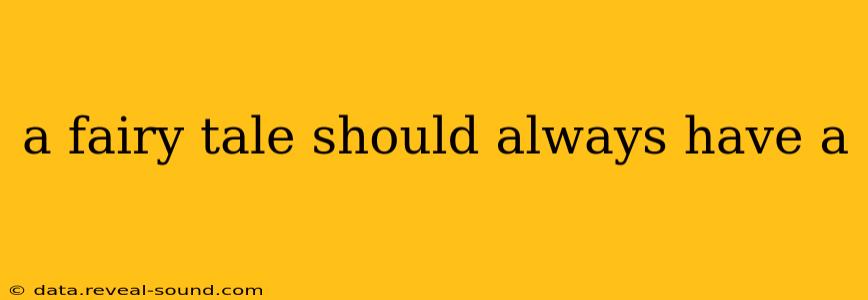A Fairy Tale Should Always Have a...Happy Ending? A Deeper Look at Fairy Tale Structure
The classic question, "A fairy tale should always have a...?" is often answered with "happy ending." While this is a common expectation, the reality is far more nuanced. A truly successful fairy tale, regardless of its ultimate resolution, possesses certain key structural elements that contribute to its enduring appeal. Let's explore what truly defines a compelling fairy tale and move beyond the simplistic "happily ever after" trope.
Does a Fairy Tale Need a Happy Ending?
While many fairy tales conclude with a sense of resolution and triumph, not all end "happily ever after." Consider the grimmer tales collected by the Brothers Grimm, some of which feature morally ambiguous characters and unsettling conclusions. These stories, while dark, still adhere to the core structural elements of a fairy tale, proving that a happy ending isn't a strict requirement. The focus shifts from the ending itself to the journey and the thematic resonance it leaves with the reader.
What are the Essential Elements of a Fairy Tale?
Instead of focusing solely on the ending, let's examine the essential elements that make a story a fairy tale:
-
Magical Elements: Enchantment, talking animals, mythical creatures—these fantastical elements are the bedrock of the genre. They create a sense of wonder and escapism, transporting the reader to a different realm.
-
Clear Moral or Theme: While not always explicitly stated, fairy tales often convey a moral lesson or explore a universal theme such as good versus evil, perseverance, or the importance of kindness. The story's meaning often transcends the literal events.
-
Archetypal Characters: Fairy tales often feature characters that embody archetypes: the wicked stepmother, the valiant knight, the damsel in distress, the wise old woman. These recognizable characters provide a framework for understanding the narrative's conflicts and resolutions.
-
A Defined Structure: Many fairy tales follow a clear structure: a problem arises, the protagonist embarks on a journey or quest, faces challenges and obstacles, and eventually reaches a resolution (which may or may not be happy). This predictable structure provides comfort and satisfaction to the reader.
-
Symbolic Language: Fairy tales often use symbolic language and imagery to represent deeper meanings. The forest might symbolize the unknown, a poisoned apple might represent temptation, and a glass slipper could symbolize societal expectations.
What Makes a Fairy Tale "Good"?
A "good" fairy tale is not simply defined by its ending. Instead, it is judged by:
- Its ability to engage the imagination: The story should spark wonder and curiosity in the reader.
- Its resonance with universal themes: The story should touch upon themes relevant to human experience across cultures and generations.
- Its narrative effectiveness: The story should be well-structured, with a compelling plot and relatable characters.
- Its impact on the reader: A great fairy tale leaves a lasting impression, prompting reflection and discussion.
Beyond the "Happily Ever After": Exploring Different Endings
While "happily ever after" is a common trope, other satisfying conclusions exist:
- Bittersweet endings: These endings acknowledge the challenges of life while still offering a sense of acceptance and closure.
- Open endings: These endings leave some questions unanswered, encouraging the reader to reflect on the story's implications.
- Moralistic endings: These endings clearly reinforce the story's moral message, often through the protagonist's reward or the antagonist's punishment.
Ultimately, a successful fairy tale doesn't need a specific type of ending to be effective. What truly matters is the presence of a compelling narrative, well-developed characters, and a resonance with universal themes. It’s the journey, the struggle, and the exploration of timeless concepts that solidify a fairy tale's enduring power, rather than a simple happily ever after.
